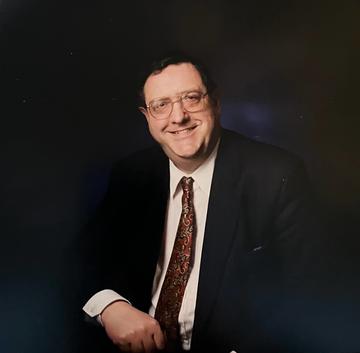Andrew Hamnett
Andrew Hamnett

It is with great sadness that we report that Andrew Hamnett died on 20th May 2025, aged 77.
Andrew was born in Stockport in November 1947 and received his secondary education at William Hulme's Grammar School in Manchester, then a part of the Direct Grant system. He was offered a scholarship to read medicine at University College, but on arrival in Oxford he switched to chemistry: a precursor to the wave of Northern Chemists recruited by John Albery during his years as Tutor for Admissions at Univ. from 1968 onward. Andrew enjoyed a brilliant undergraduate career and was Proxime Accessit to the Gibbs Prize in Chemistry Part I, before embarking on Part II research in Tony Orchard's group in the Inorganic Chemistry Laboratory (ICL). After the award of a 1st class degree, he completed his DPhil as a Senior Scholar at St John’s College, again under Tony's supervision. He then took up a Junior Research Fellowship at The Queen's College in 1972. During his years in the Orchard group, he carried out pioneering work in first gas-phase and then solid-state photoelectron spectroscopy. One paper from this era on core photoelectron spectra of simple lanthanide compounds has elicited over 1,000 citations. He was also one of the first to study radiation damage in solids while performing X-ray photoelectron experiments. Andrew was a fearless experimentalist and among the life-threatening compounds he worked on in the gas phase were RuO4 and OsO4, as well as Hg(CH3)2, Hg(CH3)(CN) and Hg(CN)2. His preparation of a sample of Be(CH3COCHCOCH3)2 without proper containment procedures led the then Professor of Inorganic Chemistry, J S Anderson, to threaten to close down experimental work in the Orchard group (the occupational exposure limit of 0.2 μg/m3 for Be and its compounds is 100 times lower than for mercury compounds and 10 times lower than for osmium tetroxide – although COSHH regulations were not in place at the time!). Andrew also contrived to cause a spectacular explosion while heating a steam can filled with amyl alcohol over a Bunsen burner to coerce an involatile acetyl acetonate into the gas phase. After these experiences, Andrew became much more safety conscious.
The Queen's JRF allowed Andrew to spend two years in Canada working in the group of Chris Brion in Vancouver. He was particularly enthusiastic about the (e,2e) electron scattering experiments he performed there, which allowed him to measure the momentum-space wavefunctions associated with orbitals in simple molecules such as H2O, NH3 and H2S. More importantly, while in Vancouver he met Suzanne, who he married in 1976.
Shortly before Andrew's return to Oxford, John Goodenough (later to become Nobel Laureate in Chemistry in 2019) arrived in the ICL as Professor of Inorganic Chemistry in 1976, with a mission to set up a wide portfolio of energy-oriented projects. Andrew was appointed as one of Goodenough's two Departmental Research Assistants and was responsible for initiating work on a range of electrochemical projects related to photoelectrolysis, electrocatalysis and air-methanol fuel cells, developing techniques such as in-situ FTIR spectroscopy, ellipsometry and electroreflectance. Andrew realised that these new approaches to interrogation of electrode/electrolyte interfaces would provide critical new insights into electrochemical processes: he and his group were among the earliest pioneers of applying these novel techniques in an electrochemical environment. Thus, a long-term collaboration with Professor A R Hillman (then at Bristol University) produced many informative studies on conducting polymers, particularly polythiophene and its derivatives.
In 1980 Andrew was elected as Lecturer in Inorganic Chemistry and Fellow by Special Election at St Catherine's College, initially for 5 years to cover for Brian Fender, who had been appointed as Director of the ILL in Grenoble. When Fender moved on to become Vice-Chancellor of Keele University, the post was confirmed as permanent.
However, in 1989 Andrew became Professor of Physical Chemistry at Newcastle University. He brought most of his research group with him, including Paul Christensen, who went on to become Professor of Pure and Applied Electrochemistry. The group continued to develop ellipsometry and in-situ FTIR techniques. At that time, Newcastle had excellent research in electrochemical engineering, and hence Andrew forged collaborations with the Chemical Engineering department in development of methanol-air fuel cells and treatment of pollutants in water by electrolysis and photoelectrolysis, thus providing fundamental research and concepts to aid the development of pilot reactors. Andrew also had collaborations across the world, from Alicante and Oporto to St Petersburg.
Recognising his outstanding organisational skills, he was appointed as Pro Vice-Chancellor for Research in 1994. In this role he steered the University through two highly successful Research Assessment Exercises. After further promotion to Deputy Vice-Chancellor, he pioneered a new era of industrial and regional liaison, which have proved crucial in establishing Newcastle as a world-class university. During his years at Newcastle, Andrew and his family lived in Morpeth, a small town 15 miles north of Newcastle, where Suzanne was ordained as a Minister of the United Reformed Church. He sang with Suzanne in the mid-Northumberland Chorus.
Progressing yet further north, in 2000 Andrew was appointed as Principal and Vice-Chancellor of Strathclyde University, the fourth individual to hold this post. During his tenure, Andrew oversaw the integration of Jordanhill College of Education into the University and reformed faculty structures to encourage collaboration and improve alignment across disciplines. His leadership led to formation of a Faculty of Education and a Faculty of Law, Arts and Social Sciences, strengthening the role of the humanities and social sciences in a university whose previous focus had been mainly technological. During his time at Strathclyde, he played a leading role in the European Consortium of Innovative Universities and facilitated establishment of an Institute of Advanced Studies to promote interdisciplinary research. He also spearheaded a number of campus redevelopment projects, including the construction of the Strathclyde Institute of Pharmacy and Biomedical Sciences, a wing of which is named after him.
Andrew was elected as a Fellow of the Royal Society of Edinburgh in 2002, received an Honorary Doctorate in Civil Law from Newcastle University in 2010, and in 2024 was awarded the title of Emeritus Principal of Strathclyde University. Aside from these formal distinctions, Andrew was a gifted linguist. He was fluent in German (passing an examination in technical German or Russian was an obligatory part of the first year Preliminary Examination in Chemistry at Oxford in the 1960s) and could also read Italian, Mandarin and Latin. When needed, he could adopt a dubious Scottish accent, a legacy of his mother’s Stewart links with southern Scotland.
After retirement from Strathclyde in 2009, Andrew and Suzanne moved back to Morpeth, where they became pillars of the local community. Andrew was much in demand as a church organist and played regularly during services at his local United Reformed Church. He also served as a trustee to the Congregational and General Charitable Trust and was treasurer of the local Rotary Club. In between these activities, he also found time to complete an Open University degree in mathematics and statistics.
He is survived by his wife Suzanne, daughters Erica, Gillian and Hilary, and grandsons Ralph and Luke.
Russell Egdell, Paul Christensen, Hilary Hamnett




